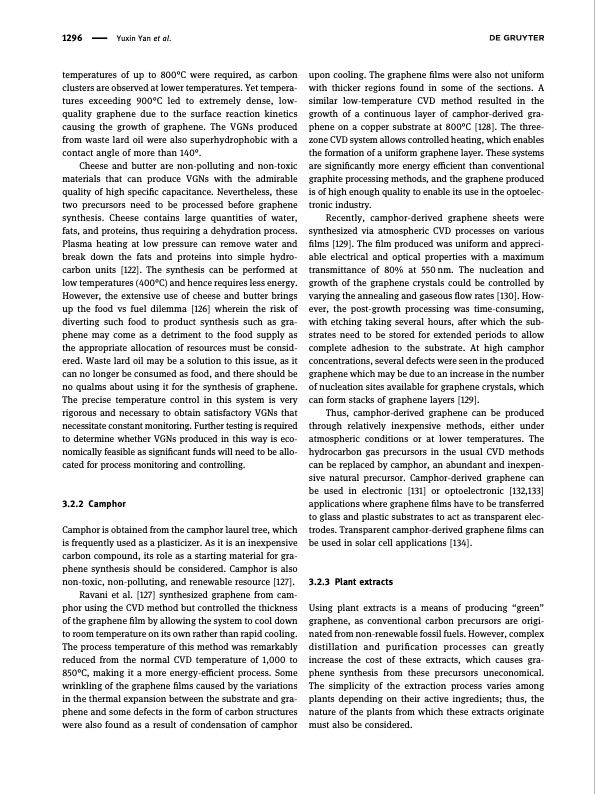PDF Publication Title:
Text from PDF Page: 013
1296 Yuxin Yan et al. temperatures of up to 800°C were required, as carbon clusters are observed at lower temperatures. Yet tempera- tures exceeding 900°C led to extremely dense, low- quality graphene due to the surface reaction kinetics causing the growth of graphene. The VGNs produced from waste lard oil were also superhydrophobic with a contact angle of more than 140°. Cheese and butter are non-polluting and non-toxic materials that can produce VGNs with the admirable quality of high specific capacitance. Nevertheless, these two precursors need to be processed before graphene synthesis. Cheese contains large quantities of water, fats, and proteins, thus requiring a dehydration process. Plasma heating at low pressure can remove water and break down the fats and proteins into simple hydro- carbon units [122]. The synthesis can be performed at low temperatures (400°C) and hence requires less energy. However, the extensive use of cheese and butter brings up the food vs fuel dilemma [126] wherein the risk of diverting such food to product synthesis such as gra- phene may come as a detriment to the food supply as the appropriate allocation of resources must be consid- ered. Waste lard oil may be a solution to this issue, as it can no longer be consumed as food, and there should be no qualms about using it for the synthesis of graphene. The precise temperature control in this system is very rigorous and necessary to obtain satisfactory VGNs that necessitate constant monitoring. Further testing is required to determine whether VGNs produced in this way is eco- nomically feasible as significant funds will need to be allo- cated for process monitoring and controlling. 3.2.2 Camphor Camphor is obtained from the camphor laurel tree, which is frequently used as a plasticizer. As it is an inexpensive carbon compound, its role as a starting material for gra- phene synthesis should be considered. Camphor is also non-toxic, non-polluting, and renewable resource [127]. Ravani et al. [127] synthesized graphene from cam- phor using the CVD method but controlled the thickness of the graphene film by allowing the system to cool down to room temperature on its own rather than rapid cooling. The process temperature of this method was remarkably reduced from the normal CVD temperature of 1,000 to 850°C, making it a more energy-efficient process. Some wrinkling of the graphene films caused by the variations in the thermal expansion between the substrate and gra- phene and some defects in the form of carbon structures were also found as a result of condensation of camphor upon cooling. The graphene films were also not uniform with thicker regions found in some of the sections. A similar low-temperature CVD method resulted in the growth of a continuous layer of camphor-derived gra- phene on a copper substrate at 800°C [128]. The three- zone CVD system allows controlled heating, which enables the formation of a uniform graphene layer. These systems are significantly more energy efficient than conventional graphite processing methods, and the graphene produced is of high enough quality to enable its use in the optoelec- tronic industry. Recently, camphor-derived graphene sheets were synthesized via atmospheric CVD processes on various films [129]. The film produced was uniform and appreci- able electrical and optical properties with a maximum transmittance of 80% at 550nm. The nucleation and growth of the graphene crystals could be controlled by varying the annealing and gaseous flow rates [130]. How- ever, the post-growth processing was time-consuming, with etching taking several hours, after which the sub- strates need to be stored for extended periods to allow complete adhesion to the substrate. At high camphor concentrations, several defects were seen in the produced graphene which may be due to an increase in the number of nucleation sites available for graphene crystals, which can form stacks of graphene layers [129]. Thus, camphor-derived graphene can be produced through relatively inexpensive methods, either under atmospheric conditions or at lower temperatures. The hydrocarbon gas precursors in the usual CVD methods can be replaced by camphor, an abundant and inexpen- sive natural precursor. Camphor-derived graphene can be used in electronic [131] or optoelectronic [132,133] applications where graphene films have to be transferred to glass and plastic substrates to act as transparent elec- trodes. Transparent camphor-derived graphene films can be used in solar cell applications [134]. 3.2.3 Plant extracts Using plant extracts is a means of producing “green” graphene, as conventional carbon precursors are origi- nated from non-renewable fossil fuels. However, complex distillation and purification processes can greatly increase the cost of these extracts, which causes gra- phene synthesis from these precursors uneconomical. The simplicity of the extraction process varies among plants depending on their active ingredients; thus, the nature of the plants from which these extracts originate must also be considered.PDF Image | Synthesis of graphene Potential carbon precursors

PDF Search Title:
Synthesis of graphene Potential carbon precursorsOriginal File Name Searched:
10-1515-ntrev-2020-0100.pdfDIY PDF Search: Google It | Yahoo | Bing
Salgenx Redox Flow Battery Technology: Power up your energy storage game with Salgenx Salt Water Battery. With its advanced technology, the flow battery provides reliable, scalable, and sustainable energy storage for utility-scale projects. Upgrade to a Salgenx flow battery today and take control of your energy future.
CONTACT TEL: 608-238-6001 Email: greg@infinityturbine.com (Standard Web Page)